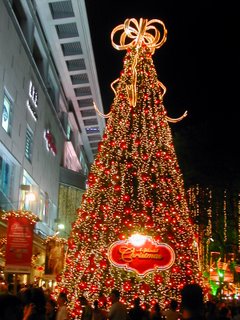Thursday, September 07, 2006
Organic Chemistry
Hydrocarbons – simplest organic compounds containing only hydrogen and carbon atoms
Alkanes – contain C-C single bonds (saturated)
Alkenes – have one or more C = C double covalent bonds (unsaturated)
Alkynes – have one or more C = C triple covalent bonds (unsaturated)
Functional grps – influence the chemical behaviour of a compound (changes its properties)
Alkanes
- CnH n+
- No functional grp
- Forms homologous series
- Saturated compounds
- Angles of 109 between the bonds (tetrahedral)
Prefix: ane
(n = number of carbon atoms)
Homologous series – a series of organic compounds that builds up by increasing by the same grp each time
Straight Chain Alkanes
1. meth methane
2. eth ethane
3. prop propane
4. but butane
5. pent pentane
6. hex hexane
7. hept heptane
8. oct octane
9. non nonane
10. dec decane
Molecular formula – gives information about the type and number of atoms present in a substance
Structural formula – shows how atoms are joined together
Condensed structural formula – represent large organic compounds
Large alkanes usually have all the CH grps collected together and written in brackets with a number
Structural isomers – same atoms but arranged differently
Branched chain structure/straight chain structure – alkanes with more than 3 carbon atoms
Parent chain – longest chain of carbon atoms
Branch chain – smaller chain of carbon atoms
Alkyl grps – branch chains (named after respective alkane, but with -yl instead of -ane)
Naming branched chain alkanes
1. Identify parent chain (name with suffix –ane)
2. Identify branch chain(s)
3. Count the number of carbons in a branch chain. Name branch by using appropriate prefix and adding –yl
4. Identify the position of the branch by numbering from the end of the parent chain which gives the branch the lowest possible number
5. Write full name as branch position, “hyphen”, branch name then parent name
If there are several identical branches on a parent chain, the position of each branch is numbered separately, and the branch names are written together using the following prefixes:
di – 2 identical branches
tri – 3 identical branches
tetra – 4 identical branches
If there are several different branches on a parent chain, they are written in alphabetical order.
If two different grps are attached in equivalent places on the same molecule, then the lower number is given to the grp which comes first alphabetically
If an organic molecule contains a branch which can only go in 1 position, then the branch number is omitted (dropped)
Cycloalkanes - alkanes with 3 or more carbons which form rings/cyclic structures
- CnH
- Higher mp and bp of alkanes
Prefix: cyclo
Physical properties of alkanes
- colourless
- non polar (insoluble in water)
- have densities less than water (float on water)
- dissolve in each other
- do not conduct electricity or heat (no delocalised electrons)
- mp and bp increase as length of carbon chain increases
- often used as solvents/grease removers
- very good fuels
At room temp alkanes with:
1) 1 – 4 carbon --- gases
2) 5 – 15 carbon -- liquids
3) 15 carbons ++ ---- soft, waxy solids
- smaller liquid alkane molecules are volatile (they become gases when heated)- volatile hydrocarbons readily ignite because plenty of vapour is available to burn
Chemical properties
Combustion (burning) (eg. Alkane + oxygen)
- water is always a product
Complete combustion – when there is lots of oxygen and carbon dioxide is produced
- flame is hot (blue flame) and clean burning (no soot)
Incomplete combustion – limited oxygen supply and CO or C (soot) will form (or a mixture of both)
- burning is incomplete
- flame may be yellow
Substitution
- alkanes undergo substitution reactions with halogens (eg. Chlorine, bromine)
Substitution reactions involve:
- loss of hydrogen from chain – involves breaking a C-H bond
- replacement of lost hydrogen by chlorine/bromine
- catalyst present (usually ultraviolet [UV] from sunlight)
- As bromine is used in substitution reactions, it decolourises [the brown colour of bromine disappears] (since bromine is ‘used up’)
Haloalkanes – halogens substituted into alkanes
Atom Name used in haloalkane
1) Bromine bromo
2) Chlorine chloro
3) Fluorine fluoro
4) Iodine iodo
- haloalkanes are named in the same way as alkanes (alphabetical order for names)
Classifying haloalkanes
1. Primary – chlorine atom is attached to a carbon atom which itself is only attached to one carbon atom
2. Secondary – chlorine atom is attached to a carbon atom which is itself attached to 2 carbon atoms
3. Tertiary – chlorine atom is attached to a carbon atom which is itself attached to 3 carbon atoms
Alkenes – hydrocarbons containing a carbon-carbon double bond (C=C)
Alkenes:
- CnH n
- Functional grp is a double bond (C=C)
- Forms a homologous series
- Unsaturated
- Angles of 120 between the bonds
Suffix: ene
- The first member of the series is ethane. (since a carbon-carbon double bond must be present, methene does not exist, only methane) Propane is the second member.
- If there are more than 3 carbons in the chain, the position of the double bond must be specified. Use a number to identify the first carbon in the double bond. The number goes between the prefix and the –ene suffix.
For branched chain alkenes:
- Parent chain contains double bond
- Position of double bond must be identified by numbering the chain from whichever end gives the double bond the lowest number
Naming branched chain alkenes:
1. Identify and name the parent chain
2. Identify the position of the double bond
3. Identify any branch chains and their positions
4. Name the molecule – branch position, branch name, parent name and double bond position
Cycloalkenes:
- CnH
Eg. Cyclohexene:
Cyclo - in a ring
Hex - 6 carbons
Ene - double bond
Geometric Isomers
- exist for alkenes that have different groups attached to both of the carbon atoms that form the double bond
1. Cis isomers – same grps are on same side of double bond
2. Trans isomers – same grps are on different side of double bond
Geometric isomerism exists because free rotation around the carbon-carbon double bond cannot occur, fixing the position in space of the grps attached to the carbon atoms of the double bond
Example: Cis and Trans isomers of but-2-ene
But-2-ene is the simplest alkene to have geometric isomers
Symmetrical alkenes have the same grps/atoms attached to 1 of the 2 carbons of the double bond
- Symmetrical alkenes do not exhibit geometric isomerism
(Hydrogen does not take part in any of geometric isomerism)
Why geometrical isomerism is only exhibited by some alkenes and is never found in alkanes
Physical properties
- non polar (insoluble in water and other polar solvents)
- good solvents for non-polar molecules
- increase in mp and bp as Molar mass/chain length increases
- float on water
Room temp (25 C) ----- ethane, propene, butane are gases
Larger alkenes - liquids
Chemical properties
1. Combustion reactions for alkenes are the same as alkanes only that alkenes do not burn as cleanly as alkanes and produce a yellow, sooty flame
2. Addition Reactions - breaking the double bond to produce a single carbon-carbon bond and 2 new single covalent bonds (reactions occurring at the double bond)
1. Hydrogenation
2. Halogenation
3. Hydration
1. Hydrogenation – 2 hydrogen atoms ‘adds across the double bond’ of the alkene to form an alkane
- catalyst is used (usually either nickel @ 150 C or platinum @ room temp [25 C])
2. Halogenation – 2 halogen atoms ‘adds across the double bond’ (usually Cl or Br)
- Bromine used to test for unsaturation because bromine loses its orange-brown colour as it reacts with alkenes.
- Loss of colour can be used to determine the rate of reaction and distinguish alkenes from alkanes
- Alkenes react without requiring a catalyst, whereas alkanes require sunlight and react slowly
- Chlorine reacts more rapidly than bromine [in addition reactions0
- Dibromo is used to indicate 2 bromine atoms. The positions on carbon 1 and carbon 2 of the 2 bromine atoms must be specified for the product toe show the bromine atoms are on different carbon atoms
- Alkenes react with hydrogen halides (eg. HCl, HBr)
forming
Hydration – alkenes react with steam (H 0) ---------- alcohol
- used for industrial preparation of ethanol
- reaction takes place when concentrated sulfuric acid is added to ethane and the mixture is then diluted with water
Addition to unsymmetrical alkenes
Unsymmetrical alkane – one that has different grps attached to 1 of them in the 2 carbon atoms of the double covalent bond
- the addition of HCl or H-OH (water) to an unsymmetrical alkene produces 2 possible product:
1. one product is produced to a greater extent (major product)
2. minor product
Markovnikov’s rule – (Rule for determining which the major product is) ---- the hydrogen atom from HCl or H-OH will bond to the carbon atom in the double bond that has the most hydrogens'
Oxidation reactions
- alkenes undergo an oxidation reaction (gain oxygen) when reacted with acidified potassium permanganate (H /MnO -)
- Purple-colour permanganate decolourises as colourless manganese (Mn ) ions form.
Unbalanced equation:
CH = CH + H /MnO ------------------ CH – CH + Mn
- Addition process used as a test for the presence of double bonds
- Alkanes do not react with potassium permanganate
- Rapid colour change between acidified potassium permanganate and unsaturated molecules
Polymers
- large organic molecules (macromolecules)
Monomers
– small organic molecules
Polymerisation – polymers form when monomers join together by covalent bonds
As polymer chain length grows:
- chaines become more tangled
- number of intermolecular forces increase
- mp increases
- polymer become stronger
Addition of polymerization
Alkynes – hydrocarbons which contain a carbon-carbon triple bond (C==C)
1. C H
2. Functional grp – triple bond (C=C)
3. homologous series
4. unsaturated compounds
5. carbon atoms in linear arrangement
Ethyne (acetylene)
Suffix: -yne
Parent chain: longest chain which contains the triple bond
Preparation of Ethyne
CaC (s) + 2H 0( ) --------- C H (g) + Ca(OH) (s)
- water must be added gradually to control this vigorous reaction [ethyne collected by downward displacement of water]
Reactions of ethyne:
- addition reactions occur when alkynes react with: bromine or hydrogen
1. One reacting molecule adds to the alkyne. Triple bond becomes double bond. Substituted alkene produced.
2. Another reacting molecule adds to substituted alkene producing a saturated product. Double bond becomes single bond.
Reaction of ethyne + chlorine forms carbon rather than 1,1,2,2-tetrachloroethane
H-C=C-H(g) + Cl (g) ------ 2C (s) + 2HCl (g)
- reaction is explosive
Alcohols
- organic compounds which contain hydroxyl (OH) functional grp
1. C H
2. Functional grp –OH
3. Forms homologous series
4. Saturated compounds
Naming alcohols
- Replace the final –e in the corresponding alkane with –ol, giving alkanol.
First 2 alcohols: methanol and ethanol
- position of hydroxyl grp must be indicated in the names for alcohols with 3 or more carbons
- hydroxyl grp in the alcohol with 3 carbons can either be on the middle carbon or the first/end carbon
1. Identify the parent chain (longest chain with the OH grp attached)
2. Identify branch chains
3. Number so the OH grp has lowest possible number. Give the position of branches.
4. Write full name as: branch positions, hyphen, branch names, parent name, OH position
Polyalcohols – alcohols with more than 1 OH functional grp
-ol suffix becomes diol for 2 hydroxyl grps and triol for 3 hydroxyl grps
Eg. Of polyalcohols
1. Propane- 1,2,3-triol (glycerol, glycerine) --- viscous liquid used in hand lotions, photography
H H H
H C C C H
OH OH OH
Used as
3. Ethane- 1,2-diol --------- antifreeze in car radiators
Classifying alcohols
1. Primary – OH grp attached to a carbon which itself is attached to 1 carbon
2. Secondary – OH grp attached to a carbon which itself is attached to 2 carbons
3. Tertiary – OH grp attached to a carbon which itself is attached to 3 carbons
Physical properties
- colourless
- mp and bp higher than alkenes because alcohols form hydrogen bonds between molecules (which are stronger than the forces between alkane molecules)
- bp increase when size of molecules increase because more intermolecular forces present
- straight chain alcohols have higher bp than branched chain alcohols
- Small alcohol molecules (less than 4 carbons) -- soluble in water
- Length of non-polar carbon chain becomes larger, alcohol molecules become less soluble because polarity decreases
- Solubility due to OH grp
- OH grp is polar due to the high electronegativity of oxygen
Alcohols with:
Less than 7 carbons --- liquids at room temp (25 C)
- small alcohols are more volatile than larger alcohols
Chemical properties:
- Combustion (same as hydrocarbons)
- Oxidation
Oxidants:
1. Acidified potassium dichromate, Cr O /H (orange to green)
2. Acidified potassium permanganate, MnO /H (purple to colourless)
Primary alcohols are oxidised and forms -- carboxylic acids
Ethanoic acid (acetic acid)
Eg.
1. Methanol oxidises to methanoic acid
2. propan-1-ol oxidises to propanoic acid
3. butan-1-ol oxidises to butanoic acid
Carboxylic Acids – contain COOH functional grp
1. Formula R-COOH (R represents hydrocarbon chain/alkyl grp)
2. Functional grp -- COOH
3. Forms homologous series
4. weak acids
5. acidic
- Functional grp is always at the end or beginning
- replace the ending-e with –oic acid
Naming carboxylic acids:
1. identify parent chain (longest carbon chain with COOH attached to the end)
- The C of COOH is always carbon 1
2. identify branch chain
3. identify position of branches
4. write full name as: branch position – branch name and parent name, acid
Eg.
1. Methanoic acid HCOOH
2. Ethanoic acid CH COOH
Physical properties:
- small carboxylic acids (low molecular mass) - soluble in water because COOH grp is polar due to high electronegativity of the 2 oxygen atoms
- solubility of acids decrease as non-polar carbon chain length increases
- colourless liquids or white solids at room temp.
- higher mp and bp than hydrocarbons and alcohols because of their increased molar mass and their ability to form strong hydrogen bonds
Short-chain carboxylic acids --- strong, unpleasant odours
Higher mass (lower volatility) carboxylic acids are less smelly
- Smell of rancid butter caused by butanoic acid
1. Ions formed from carboxylic acids are named by replacing the –ic acid by –ate
Eg. Ethanoic acid ---- ethanoate ions
Methanoic acid ---- methanoate ions
Solutions of carboxylic acids will:
1. turn blue litmus -- red
2. conducts electricity (sufficient number of ions are present and free to move)
forming
3. reacts slowly with metals ------ hydrogen gas
2H (aq) + Mg(s) -- Mg (aq) + H (g)
forming
4. reacts with bases (neutralisation reaction) -------- water
CH COOH (aq) + OH (aq) ----------- CH COO (aq) + H O( )
forming
5. reacts with carbonates and hydrogen carbonates -------- water + carbon dioxide
2CH COOH + CO -- 2CH COO + H 0
CH COOH + HCO ---- CH COO + H 0 + CO (g)
produce
Acid reactions with metals, bases, carbonates ------- organic salts. These salts disappear as crystalline solids when the aqueous solution is evaporated
Eg.
Magnesium + ethanoic acid ----------- magnesium ethanoate + hydrogen gas
Mg + 2CH COOH --- (CH COO) Mg + H (g)
Esters – organic compounds with the formula R-C-O-R [R and R are alkyl grps]
O
1. C H O
2. Functional grp -- COO
3. Forms homologous series
4. gives off a sweet smell when formed
Most esters are:
- oily volatile liquids
- very slightly soluble in water because they are slightly polar
Esterification - Carboxylic acids + alcohols ----- esters (example of a condensation reaction) because OH (part of an acid) and the H (part of the hydroxyl grp) [alcohol] combine to form water (as a product)
R-C-OH + R------OH ------ R-C-O-R + H 0
------
O O
Carboxylic acid + alcohol -----> ester + water
-----
- reaction is reversible as ester can react with water, producing acid + alcohol again
Dehydrating agent – removes water from esterification
- addition of concentrated sulfuric acid increases the amount of ester formed by preventing the backward reaction from occurring (concentration H SO ) acts as a catalyst and dehydrating agent, removing water from reaction mixture
Naming esters:
1. ‘Split’ the molecule in 2 about –O-
2. name the part identifying the alcohol (part with –O- grp) by replacing –ane of the alkane with –yl
3. name the part identifying the acid identified by replacing –ane of the alkane with –oate
4. Place the alcohol derived part (-yl part) before the acid part (-oate part)
When writing equations:
1. write carboxylic acids first
2. write alcohols second
When naming esters:
1. Write alcohols first
2. Write carboxylic acids second
Hydrolysis of Esters – ‘reverse’ of esterification and results in the ester molecule being split apart
Presence of acid catalyst - carboxylic acid + alcohol formed
In basic conditions, alcohol + carboxylate ion, RCOO will be formed
Sources and uses of esters:
- most esters occur naturally
- have pleasant fruity smells
- found in flowers and fruits
Fatty acids – carboxylic acids with long hydrocarbon chains containing even numbers of carbon atoms
- Fatty acids can be represented as RCOOH (R stands for long chain)
Esters of fatty acids --- fats and oils
Fats:
- Soft solids @ room temp.
- saturated compounds
- found in animals
(eg. Stearic acid)
- Stearic acid is a saturated fatty acid because the long hydrocarbon chain has no double bonds between any carbon atoms
- Oleic acid is an unsaturated fatty acid because it contains a double bond between carbons 9 and 10
Oils:
- liquids @ room temp.
- unsaturated compounds
- come from plant sources (eg. Seeds, nuts, berries)
Polyunsaturated fatty acids ---- fatty acids with more than 1 double bond (from plant sources)
Triglycerides
- occur naturally as oils in seeds, nuts, berries, fats
1 glycerol molecule + 3 fatty acid molecules (by ester linkages) -------- triglycerides
- These ester linkages arise because alcohol grps on the glycerol react in an esterification reaction with the COOH grps of fatty acids
Glycerol tristearate is a triglyceride formed from the esterification reaction between glycerol and 3 stearic acid molecules
Soap
Saponification -- soap is formed when NaOH + triglyceride molecules ------ sodium salts
- reverse of esterification
- OH ions break ester linkages to form fatty acid anions and glycerol (as a by-product)
- As the mixture cools, the sodium cations from NaOH and fatty acid anions from triglyceride combine to form soap. The hydrocarbon chains (R, R’ and R””) determine the type of soap produced
- If KOH is used instead of NaOH, soft liquid soaps are produced
with loves; christine
6:53 PM















